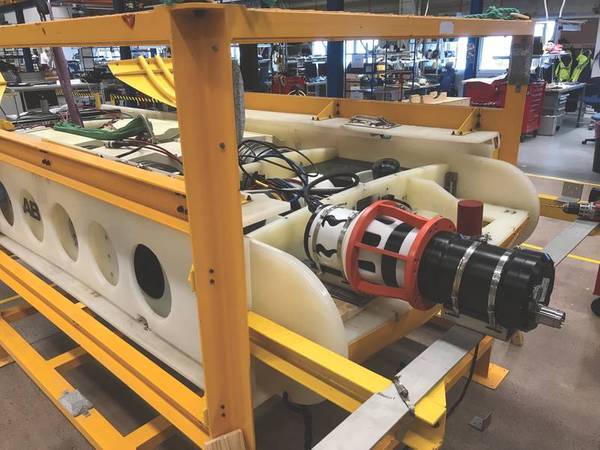
Blue Logic, based near Stavanger in Norway, is not the only firm producing inductive subsea connectors (WiSub, near Bergen is doing similar), but Blue Logic has been heavily involved in building a key piece of the infrastructure that will enable so-called resident subsea vehicles to remain subsea for long periods performing inspection and intervention operations. It’s the subsea docking station (SDS) for Equinor’s underwater intervention drone concept (UiD – a name trademarked by Equinor). Two have so far been built, with one now installed in 365 meters water depth offshore Trondheim, at an open test lab run by the Norwegian University of Science and Technology (NTNU), and another due to be installed at the Aasgard field offshore Norway, following a detour to Sweden, where it was trailed with a Saab Seaeye Sabertooth autonomous underwater vehicle (AUV). Equinor not only outsourced the creation of these SDSs, but it’s also making the design freely available – because it wants all vehicle vendors to use it (open innovation).
Blue Logic’s founders produced their first inductive connector for power and high-speed communication in 2006, following 12 years work. In 2010, they founded Blue Logic and since then the company has been improving their inductive connectors, for power and communications transfer, and new power alternatives ranging from 50W to 2.3kW, all with ethernet and serial communication speeds up to 80 Mbps and 230kbps respectively. It’s also working on a next generation 9.2kW connector, as well as other types of mechanical and hydraulic connectors for drones.
Blue Logic has also developed a new torque tool for AUVs and remotely operated underwater vehicles (ROV). Its previous torque tool weighed 23kg in water, which would have been too heavy for a vehicle like the Eelume snake robot, says Helge Sverre Eide, Blue Logic’s business manager. So engineer Lars Gunnar Hodnefjell worked on a lighter version - 7.5kg in fact (improving the world record by 50% weight reduction)- using titanium and plastic – producing 3,000Nm of torque. It’s since been used by the Eelume, which is due to operate out on the SDS at Asgard on a tethered trial.
But, “for this (subsea resident vehicles) to be economical, you need to increase the scope of work for drones,” says Eide. “So, you need new tools and you need to adjust or change the subsea production system. You need to change both sides of the equation. New tools must be lightweight so a drone can fly them. Subsea maintenance of systems needs to change to smaller portions to change out sensors and other components by use of drones.”
The current SDS design has two 2kW, and two 50W Blue Logic connector and one 250W WiSub connector, markings - AruCo and ChaRuCo – which drone cameras can see and from which they can decide their position relative to them, and acoustic positioning from Trondheim based Water Linked. In future, the magnetic field of Blue Logic’s the inductive connector could also be used to guide the drone on to the SDS, says Eide.
Blue Logic is in the Subsea Wireless Group (SWiG), which is working to standardize subsea wireless communications also.